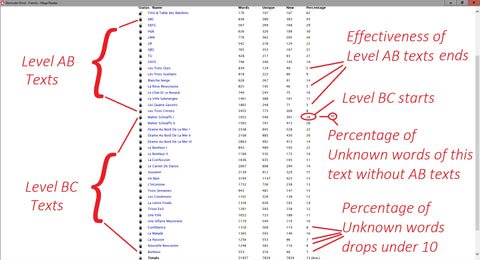
Learning Better Through Stories
Share
Mastering Vocabulary with Spaced Repetition in Language Learning Stories
Learning a new language is an adventure, a journey of exploration and growth. Yet, one of the most daunting tasks is acquiring a rich vocabulary that allows for fluid comprehension and expression. Traditional methods, such as rote memorization and endless lists of words, can quickly lead to burnout and inefficiency. What if there were a more engaging, sustainable, and effective way to expand one's lexicon?
This post is for language learners who aspire to enhance their vocabulary with a technique that leverages both the power of narrative and the science of spaced repetition. We’ll explore how integrating these elements into the learning process can not only increase the rate at which we learn but also improve our long-term retention of new words.
The Journey Begins: Understanding Spaced Repetition
Spaced repetition is a learning technique that incorporates increasing intervals of time between subsequent review of previously learned material. Conceptualized by psychologist Hermann Ebbinghaus in the late 19th century and popularized in contemporary education technology, this method capitalizes on the psychological spacing effect which dictates that we are more likely to remember information if we learn it gradually over time.
In essence, spaced repetition optimizes the learning process by presenting information at the moment when the learner is about to forget it. This not only improves the efficiency of learning but also helps to transfer the information from short-term to long-term memory.
The Art of Storytelling in Language Acquisition
Storytelling is a universal human experience that transcends cultural and linguistic barriers. Embedded within narratives are the intricacies of language—vocabulary, grammar, and context—all seamlessly interwoven to convey a message. Leveraging storytelling in language learning provides a context for the new vocabulary, creating a richer and more memorable learning experience.
Integration of Gloss Text and High-Frequency Vocabulary
One way to harness the power of spaced repetition within narratives is through the use of gloss texts. Gloss texts are marked with annotations or small glosses, providing additional context and translation for less common or specialized vocabulary. They allow learners to engage with texts that may initially be beyond their current vocabulary level.
In this method, stories are written with interlinear glosses, where the original language is aligned with a translation or interpretation into the learner's language. The text might contain words or phrases that are essential to the narrative but not yet part of the learner's active vocabulary. These glosses offer learners the opportunity to read, understand, and subsequently reinforce these target words at optimal intervals.
Furthermore, learners can also highlight or mark high-frequency words in the text, ensuring that they revisit and review these critical terms appropriately. For instance, common verbs, adjectives, and nouns can be identified and focused on during story readings, either by rereading the sentence or by practicing these words through additional exercises.
An sample of our texts showing the level of vocabulary acquisition

Crafting the Right Content for Spaced Repetition
The effectiveness of spaced repetition in expanding vocabulary pivots on the content. For long-term engagement and sustainable learning, it is crucial to select texts that captivate and maintain the learner’s interest. The stories should be complex enough to introduce and reinforce a broad spectrum of words, while not so challenging that they discourage the learner.
One approach is to use stories as part of a progressive series. This approach allows for the gradual increase in complexity and inclusion of new vocabulary as the learner progresses. It’s like a serial in which the plot thickens and the characters develop, creating a sustained interest over time.
Multifaceted Practice Strategies
Practice, in the context of spaced repetition, doesn’t just involve the simple act of reading. Engage in various activities around the story that reinforce the newly acquired words. This might involve writing summaries, retelling the story in your own words, or even creating new content based on the original text. Each of these activities will reinforce the spaced repetition of vocabulary in subtly different ways, ensuring a robust and multifaceted knowledge of the words.
Digital Tools for Enhanced Learning
Advancements in technology have introduced digital tools tailored to support spaced repetition learning. Language learning apps and software now utilize sophisticated algorithms to curate personalized learning experiences based on the spaced repetition model. These tools often incorporate story-based content and interactivity, not only increasing the efficiency of vocabulary acquisition but also enhancing the learning process.
Real-World Application and Verbal Practice
The true test of vocabulary acquisition is its application in real-world situations. Verbal practice, either through conversations or oral exercises, solidifies the words in the learner's active lexicon. Engage with others, listening, and conversing to experience the words in their natural contexts.
Continuous Assessment and Adjustment
Lastly, it is important to continuously assess and adjust the learning process. Pay attention to the words that stick and those that need more revision. Adapt the spaced repetition intervals based on how well you remember each word, and do not hesitate to change the content or methodology if something isn’t working for you.
The Science Behind HypLern
The use of stories or contextual learning environments, including interlinear texts, can significantly enhance the effectiveness of spaced repetition for several reasons:
- Contextual Learning: Words learned in context are more easily remembered because the story provides a "memory hook" for the new vocabulary. When learners encounter a word within a narrative or a meaningful sentence, they're not just memorizing the word in isolation but are also learning its usage, connotations, and connections to other words.
- Emotional Engagement: Stories often evoke emotions, which can increase the likelihood of a learner remembering the vocabulary used. Emotional engagement with the material makes the learning process more enjoyable and memorable.
- Repeated Exposure in Varied Contexts: Spaced repetition in the context of stories means encountering vocabulary at spaced intervals across different contexts within the narrative. This varied repetition helps solidify the learner's understanding and recall of the word, as they see it used in multiple ways.
- Enhanced Recall Through Narrative Structure: The structure of a story (beginning, middle, end) can help learners remember the words they encountered in the narrative. The chronological progression of events in a story helps in anchoring vocabulary in learners' memories.
For vocabulary learning through spaced repetition in stories specifically, consider the HypLern method, which incorporates interlinear texts. Interlinear texts provide the original language text along with a literal word-for-word translation underneath. This method facilitates learning vocabulary in context, allowing learners to understand the story in the target language while simultaneously learning new words. The spaced repetition could come into play by revisiting the same story or related texts at spaced intervals, reinforcing the vocabulary learned previously.
The Last Word
Spaced repetition within the context of language learning stories is a dynamic, fun, and scientifically proven method for expanding your vocabulary. By immersing yourself in narratives enriched with high-frequency words and employing various practice strategies, you can ensure your language learning is not only efficient but also deeply engaging and memorable.
The language you're learning becomes more than a series of sounds or letters; it transforms into a living, breathing entity with which you can interact and build new realities. Now, it's time to pick up a story and start your enriching, unforgettable vocabulary-building adventure!
